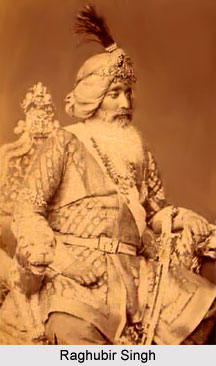 Raghubir Singh was a prominent ruler or Maharaja of the princely state of Jind who ruled from the year 1864 to 1887. He was born in the year 1834 at Bazidpur and belonged to the Phulkian dynasty. He was the youngest son of Maharaja Swarup Singh of Jind. After the death of his elder brother, Raghubir Singh became heir apparent to his father Swarup Singh of Jind in 1848. During the Great Uprising, Raghubir Singh fought along with his father in a number of the main battles against the rebels. After the death of his father in the year 1864, Raghubir Singh succeeded his and ascended the gadi or throne of Jind and had his coronation on 31 March 1864. Sir Robert Montgomery, the Lieutenant Governor of the Punjab attended the coronation, along with the head of the Phulkian dynasty, the Maharaja of Patiala.
Raghubir Singh was a prominent ruler or Maharaja of the princely state of Jind who ruled from the year 1864 to 1887. He was born in the year 1834 at Bazidpur and belonged to the Phulkian dynasty. He was the youngest son of Maharaja Swarup Singh of Jind. After the death of his elder brother, Raghubir Singh became heir apparent to his father Swarup Singh of Jind in 1848. During the Great Uprising, Raghubir Singh fought along with his father in a number of the main battles against the rebels. After the death of his father in the year 1864, Raghubir Singh succeeded his and ascended the gadi or throne of Jind and had his coronation on 31 March 1864. Sir Robert Montgomery, the Lieutenant Governor of the Punjab attended the coronation, along with the head of the Phulkian dynasty, the Maharaja of Patiala.
Rule of Raghubir Singh
Maharaja Raghubir Singh of the princely state of Jind began a long campaign his personal residence at Sangrur and commenced a, extensive campaign to modify and restructure his state. He modified the Sangrur bazaar, constructed temples and built gardens, public buildings, water reservoirs and paved roads for the betterment of his subjects. During the Kuka outbreak in the year 1872, Singh contributed a contingent of the Jind artillery for service. He faced severe problems of revolt in 1874, in his territory of Dadri, including in some other regions that were acquired after 1857. But eventually Raghubir Singh took personal command of his army and restrained the revolt within the period of a month.
Singh sent 700 cavalry and infantry during the Second Afghan War in order to support the British forces in Afghanistan. Raghubir Singh was appointed as a Councillor of the Empire in 1877. Later in the year 1881, he was honoured with the title of Raja-i-Rajgan. Raghubir Singh was knighted with the highest imperial dignity, the Knight Grand Commander of the Order of the Star of India (GCSI) in 1875 and was honoured with the Kaiser-i-Hind (KIH) in 1877. He also received the Companion of the Order of the Indian Empire (CIE) in the year 1878.
Personal Life of Raghubir Singh
Raghubir Singh of Jind was married twice; firstly to Her Highness Dadriwale Rani Sri Sama Kaur Sahiba, who was the daughter of Chaudhuri Jawahar Singh of Dadri. The royal couple had a daughter and a son. His son Tikka Sri Balbir Singh Sahib Bahadur had a daughter and a son named Ranbir Singh, who succeeded his grandfather Raghubir Singh as the Maharaja of Jind.
Raghubir Singh died at the age of 53, on 7th March 1887 after a reign of 23 years. He was succeeded by Ranbir Singh, his grandson.
Titles of Raghubir Singh
* Maharajkumar Sri Raghubir Singh (1834- 1848)
* Sri Tikka Sahib Raghubir Singh Bahadur (1848- 1864)
* His Highness Farzand-i-Dilband, Rasikh-ul-Itiqad-i-Daulat-i-Inglishia, Raja Sri Raghubir Singh Bahadur, Raja of Jind (1864- 1875)
* His Highness Farzand-i-Dilband, Rasikh-ul-Itiqad-i-Daulat-i-Inglishia, Raja Sri Sir Raghubir Singh Bahadur, Raja of Jind, GCSI (1875- 1877)
* His Highness Farzand-i-Dilband, Rasikh-ul-Itiqad-i-Daulat-i-Inglishia, Raja Sri Sir Raghubir Singh Bahadur, Raja of Jind, GCSI, KIH (1877- 1878)
* His Highness Farzand-i-Dilband, Rasikh-ul-Itiqad-i-Daulat-i-Inglishia, Raja Sri Sir Raghubir Singh Bahadur, Raja of Jind, GCSI, CIE, KIH (1878- 1881)
* His Highness Farzand-i-Dilband, Rasikh-ul-Itiqad-i-Daulat-i-Inglishia, Raja-i-Rajgan, Raja Sri Sir Raghubir Singh Bahadur, Raja of Jind, GCSI, CIE, KIH (1881- 1887)
Honours of Raghubir Singh
* Knight Grand Commander of the Order of the Star of India- GCSI (1875)
* Prince of Wales Gold Medal (1876)
* Kaiser-i-Hind Gold Medal- KIH (1877)
* Companion of the Order of the Indian Empire- CIE (1878)






































